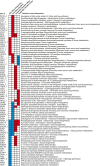Mapping condition-dependent regulation of metabolism in yeast through genome-scale modeling
- PMID: 23631471
- PMCID: PMC3648345
- DOI: 10.1186/1752-0509-7-36
Mapping condition-dependent regulation of metabolism in yeast through genome-scale modeling
Abstract
Background: The genome-scale metabolic model of Saccharomyces cerevisiae, first presented in 2003, was the first genome-scale network reconstruction for a eukaryotic organism. Since then continuous efforts have been made in order to improve and expand the yeast metabolic network.
Results: Here we present iTO977, a comprehensive genome-scale metabolic model that contains more reactions, metabolites and genes than previous models. The model was constructed based on two earlier reconstructions, namely iIN800 and the consensus network, and then improved and expanded using gap-filling methods and by introducing new reactions and pathways based on studies of the literature and databases. The model was shown to perform well both for growth simulations in different media and gene essentiality analysis for single and double knock-outs. Further, the model was used as a scaffold for integrating transcriptomics, and flux data from four different conditions in order to identify transcriptionally controlled reactions, i.e. reactions that change both in flux and transcription between the compared conditions.
Conclusion: We present a new yeast model that represents a comprehensive up-to-date collection of knowledge on yeast metabolism. The model was used for simulating the yeast metabolism under four different growth conditions and experimental data from these four conditions was integrated to the model. The model together with experimental data is a useful tool to identify condition-dependent changes of metabolism between different environmental conditions.
Figures





References
Publication types
MeSH terms
Substances
Grants and funding
LinkOut - more resources
Full Text Sources
Other Literature Sources
Molecular Biology Databases
Miscellaneous

